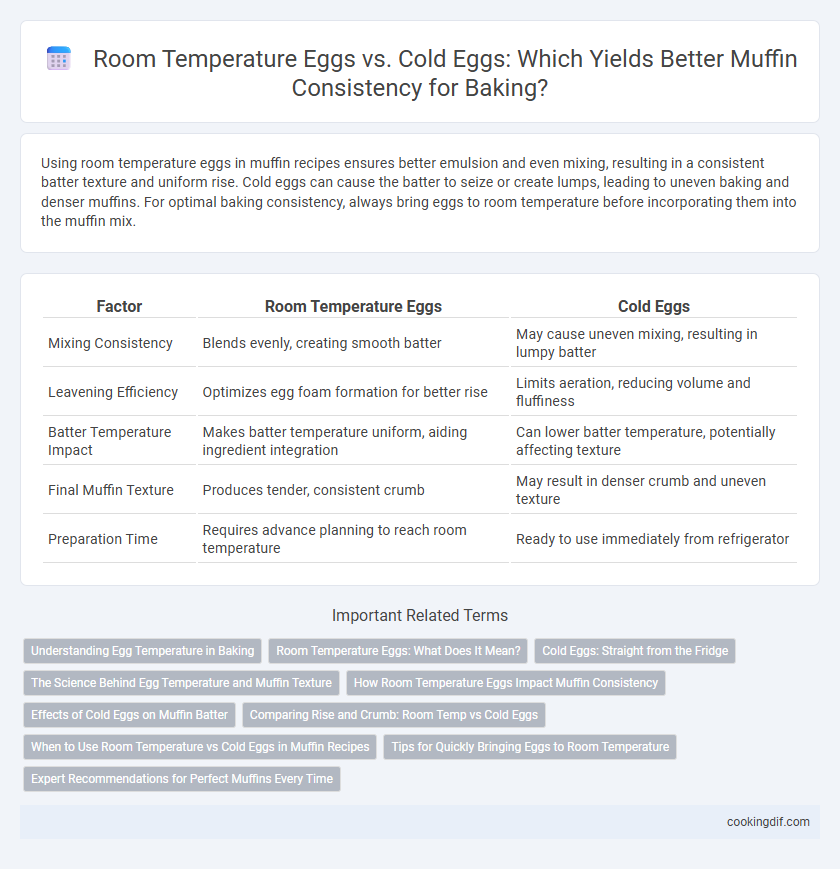Using room temperature eggs in muffin recipes ensures better emulsion and even mixing, resulting in a consistent batter texture and uniform rise. Cold eggs can cause the batter to seize or create lumps, leading to uneven baking and denser muffins. For optimal baking consistency, always bring eggs to room temperature before incorporating them into the muffin mix.
Table of Comparison
| Factor | Room Temperature Eggs | Cold Eggs |
|---|---|---|
| Mixing Consistency | Blends evenly, creating smooth batter | May cause uneven mixing, resulting in lumpy batter |
| Leavening Efficiency | Optimizes egg foam formation for better rise | Limits aeration, reducing volume and fluffiness |
| Batter Temperature Impact | Makes batter temperature uniform, aiding ingredient integration | Can lower batter temperature, potentially affecting texture |
| Final Muffin Texture | Produces tender, consistent crumb | May result in denser crumb and uneven texture |
| Preparation Time | Requires advance planning to reach room temperature | Ready to use immediately from refrigerator |
Understanding Egg Temperature in Baking
Room temperature eggs blend more evenly into muffin batter, resulting in a smoother texture and improved rise compared to cold eggs. Cold eggs can cause uneven mixing, leading to dense or unevenly baked muffins. Understanding egg temperature helps maintain consistent muffin quality by ensuring proper emulsification and even heat distribution during baking.
Room Temperature Eggs: What Does It Mean?
Room temperature eggs refer to eggs that have been left out of the refrigerator for about 30 minutes to an hour, allowing them to reach a temperature close to the ambient room temperature, typically around 68-72degF (20-22degC). Using room temperature eggs in baking ensures better emulsification with other ingredients, resulting in a smoother batter and more consistent muffin texture. This temperature harmony improves aeration and volume, delivering lighter muffins with even crumb structure compared to using cold eggs straight from the fridge.
Cold Eggs: Straight from the Fridge
Cold eggs straight from the fridge can affect baking consistency by slowing the mixing process and resulting in denser batter due to lower liquid incorporation. Their lower temperature can cause uneven mixing of fats and sugars, leading to muffins with less rise and a tighter crumb. To achieve optimal texture and fluffiness in muffins, eggs should be allowed to reach room temperature before blending.
The Science Behind Egg Temperature and Muffin Texture
Egg temperature significantly affects muffin texture by influencing batter emulsification and leavening gas retention; room temperature eggs blend more thoroughly with other ingredients, creating a smoother batter that traps air better for consistent rise. Cold eggs slow the mixing process, potentially resulting in a denser, tougher crumb due to uneven fat dispersion and incomplete incorporation of air bubbles. Scientific studies on protein denaturation highlight that warmer eggs optimize coagulation during baking, enhancing moisture retention and producing tender, fluffy muffins.
How Room Temperature Eggs Impact Muffin Consistency
Room temperature eggs blend more evenly with other ingredients, creating a smoother batter that improves muffin texture and rise. Cold eggs can cause the batter to curdle, resulting in uneven crumb and denser muffins. Using room temperature eggs enhances moisture distribution and supports consistent muffin structure.
Effects of Cold Eggs on Muffin Batter
Cold eggs in muffin batter can cause uneven mixing, resulting in denser, less tender muffins due to temperature shock affecting the leavening agents. Using room temperature eggs ensures better emulsification with the fat and sugar, promoting a smoother batter texture and consistent rise. Consistent batter temperature helps maintain the activity of baking powder or baking soda, directly influencing the muffin's volume and crumb quality.
Comparing Rise and Crumb: Room Temp vs Cold Eggs
Room temperature eggs incorporate air more effectively, resulting in a better rise and lighter crumb in muffins compared to cold eggs. Cold eggs cause batter to mix unevenly, leading to denser texture and less volume. For optimal baking consistency, using room temperature eggs enhances muffin fluffiness and uniform crumb structure.
When to Use Room Temperature vs Cold Eggs in Muffin Recipes
Room temperature eggs blend more easily into muffin batter, ensuring a smoother, more consistent texture and better rise, especially in recipes requiring precise leavening agents like baking powder. Cold eggs are ideal when a thicker batter is preferred, as they help maintain structure and prevent over-mixing, key for denser, moister muffins. Adjusting egg temperature based on the desired muffin outcome improves overall baking consistency and final crumb quality.
Tips for Quickly Bringing Eggs to Room Temperature
Cold eggs can cause batter to curdle and prevent proper mixing, affecting muffin texture and rise. To quickly bring eggs to room temperature, place them in a bowl of warm water for 5 to 10 minutes or let them sit on the counter while prepping ingredients. Using room temperature eggs improves emulsification, resulting in consistent muffin crumb and even baking.
Expert Recommendations for Perfect Muffins Every Time
Experts recommend using room temperature eggs for baking muffins to ensure even mixing and consistent texture, as cold eggs can cause batter to curdle or not blend smoothly. Room temperature eggs help achieve a uniform rise and tender crumb, enhancing the muffin's overall quality. For perfect muffins every time, allow eggs to sit out for about 30 minutes before incorporating into your recipe.
Room Temperature Eggs vs Cold Eggs for baking consistency Infographic

 cookingdif.com
cookingdif.com